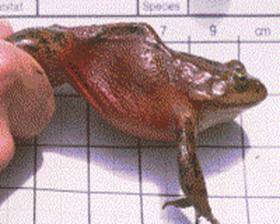Breeding habitat and local population size of the Oregon spotted frog (Rana pretiosa) in Oregon, USA
http://fresc.usgs.gov/products/RequestReprint.aspx?ProductNumber=1985
Abstract/Summary
The distribution of the Oregon Spotted Frog (Rana pretiosa) has shrunk markedly and more than 2/3 of known populations are located along the Cascade Range in central Oregon. Despite the conservation concern, little is known about how habitat attributes and stressors such as invasive species influence R. pretiosa populations. We used egg mass counts to study R. pretiosa habitat relationships at oviposition sites and breeding ponds. Oviposition sites were in shallow water above gradually sloping substrates that supported moderate or dense herbaceous vegetation. Sixty-one per cent of occupied breeding ponds had fewer than 20 egg masses. We found strong support for two predictors of egg mass count: positive effect of other R. pretiosa breeding sites nearby and a negative effect of non-native fish having access to preferred R. pretiosa overwintering habitat. We found moderate support for effects of emergent and submergent vegetation coverage (positive) and of ponds being located in the Klamath Basin (negative). Maintaining and restoring overwintering habitats that are free of non-native game fish is likely to benefit R. pretiosa. Further work on movement ecology is needed to improve our understanding of habitat connectivity and the effects of site isolation on the persistence of R. pretiosa in Oregon.
Publication details
| Published Date: | 2010 |
| Outlet/Publisher: | Northwestern Naturalist 91 |
| Media Format: |
ARMI Organizational Units:
Pacific Northwest - BiologyTopics:
Monitoring and Population EcologySpecies and their Ecology
Place Names:
Pacific NorthwestKeywords:
distributionhabitat
introduced species
invasives
T&E

